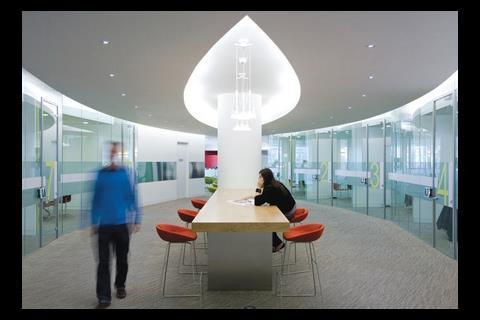With the commercial world in turmoil, the public sector is drawing more and more attention â just as well then, that these days it can match private facilities for design flare and value.
There was once a time when you could identify a public sector office just by looking at it. Those days are now gone, says Overbury managing director Chris Booth â swept away by huge changes to the nature of peopleâs workplaces.
âNow they are as sophisticated as commercial facilities,â he says, adding that central government and local authority clients are no longer looking for just the cheapest solution, but for value for money as well.
He should know â public sector offices now make up 30% of Overburyâs turnover compared with just 5% 10 years ago. Clients include the Department for Work and Pensions, Defra and the International Maritime Organisation.
In that time, many local authorities have followed the private sector in embracing new ways of working and realising the important role that the workplace can play in attracting and retaining staff. And as sustainability moves up corporate and government agendas, public sector clients are seeing the value â both environmentally and politically â of looking at lifetime costs rather than lowest price alone.
All this has been helping to raise standards over the last four or five years, according to David Mathieson, director of construction management consultancy Turner & Townsend. He specialises in the public sector and worked with Overbury on the recent IMO fit-out. âThereâs a recognition that you have to spend to achieve longer-term efficiencies,â he says. âThere tends to be a right price for a project and clients are more sophisticated in understanding it, and thinking quite carefully about what best value means for them.â
Network Railâs new Manchester offices, designed by BDGworkfutures and fitted out by Overbury, demonstrate the improved standards in the design of non-commercial offices. The 100,000ft2 offices are arranged over four floors within Square One, a former post office building, and have lofty 3.6m floor-to-ceiling heights. It won its regional category at this yearâs British Council for Offices Awards.
Network Rail had previously operated out of several offices, all with narrow floor plates which summed up many of the more negative historic traits of public sector premises. âIt was a hugely inefficient environment to work in,â says BDGworkfutures director Clive Hall. âThere were extremely old services â it was too hot in summer, too cold in winter. They needed to update both their equipment and their space.â
The aim was to create an environment that the highly disparate staff could take pride in. âThe challenge at Network Rail was to attract high-level, high-calibre staff into the industry. To do that you need parity with the commercial sector,â says Hall.
It helped that the client, as is increasingly the case in this sector, was keen to invest in its workplace, according to Layne Mercer, of GVA Grimley, who was in charge of project management and quantity surveying at Square One. âWeâve certainly seen a willingness to invest further, and more of an understanding in the benefits this can have on staff morale and retention, and attracting them in the first place,â he says, citing the commitment at Network Rail to the stand-out feature of the scheme, the ârugby ballâ at the heart of the floor plan.
This elliptical area is positioned at the centre of the floor plate and provides glazed meeting rooms, space for large staff meetings, storage, break-out facilities and a very long table. The main areas of desking â supplied



















